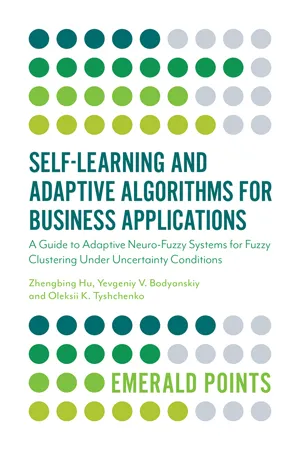1.1. LEARNING AND SELF-LEARNING PROCEDURES
A learning process always involves a system which can be described by a vector of parameters to be learned
and input data which are a sequence of observations
, where an
n-dimensional feature vector gives observation for each object
. We can define a function describing a system’s error by Eq. 1.1 (Tsypkin, 1970):
where
is some predefined objective function and
is the density distribution for
in
.
For a continuous function
, the purpose of learning procedure is to achieve an optimum state for the system
when the functional (
Eq. 1.1) attains an extremum value
. Usually, the state
cannot be determined accurately due to the lack of information, as, in general, the distribution density
is also unknown.
If some information about the desired reaction for the system is available for a subset
, it is called a learning set (a training set), and responses
corresponding to each element are called a learning signal (a training signal). Thus the purpose of learning procedure, in this case, is to minimize the differences between a system’s actual output
and desired output
. The objective function
which minimizes the functional (
Eq. 1.1) can be defined (in the purest form) as
Analytical or numerical minimization of these objective functions leads to a variety of supervised learning algorithms.
If the training signal
is unavailable, construction of the objective function becomes less trivial. In the most general terms, the self-learning process aims to minimize a divergence between the actual density function
p(
x) and the approximated one
based on the system’s performance:
Since neither
nor
can be measured directly, it leads to a wide variety of objective functions and algorithms based on these functions.
The main feature of intelligent systems is their ability of learning and self-learning, i.e., the ability to make generalizations based on available and incoming data. This fact allows them to be used for solving problems automatically under specific conditions, such as lack of a priori information about the data nature and the subject area.
Learning procedures can be described in the form of stochastic difference and differential equations for tunable parameters of a system. In some cases, these equations have an exact solution, but numerical methods are commonly used to ensure an asymptotic convergence to an optimal solution. This leads to the fact that most of the learning procedures are iterative.
Most of the learning procedures can be attributed to either of these two basic classes: supervised learning and unsupervised learning (self-learning). In the supervised learning case, the data contain both input information and examples of desired system responses to the input data that make it possible to train the system by comparing its output signal with samples. In case of unsupervised learning, the system has no information about desired outputs, and its task is to detect patterns in a dataset when any data element is not a solution.
1.2. CLUSTERING
Clustering (automatic classification) is one of the primary tasks in data mining, and it implies isolation of similar observations in a dataset in the most general case. In the formal form, the clustering problem is formulated as follows: given a data sample
consisting
observations
where each observation is an
n-dimensional feature vector,
. It is often convenient to have a data sample in a matrix form
. These forms are similar.
A solution for the clustering problem is to find a partition matrix
where
stands for an observation’s membership level
to the
–th cluster,
. A general formulation of the problem does not regulate whether some clusters are set beforehand or found by an algorithm.
The feature that differentiates this problem statement from the classification is that no membership tag is specified for a group for any data subset, i.e., clustering is an unsupervised task.
Decision for clustering problems is fundamentally ambiguous. The various reasons for this are as follows:
(1) There is no best or universal quality criterion or objective function for a clustering problem. However, there is a vast number of heuristic criteria, as well as some algorithms without a clearly expressed criterion, and all of them can give different results.
(2) Some clusters are usually previously unknown and are set based on some subjective considerations.
(3) A clustering result strongly depends on a metric which is typically subjective and determined by an expert.
(4) Evaluation of the clustering quality is also subjective.
1.2.1. Clustering Methods
Although there are a lot of clustering approaches, this book mainly focuses on prototype-based methods (Borgelt, 2005; Xu & Wunsch, 2009). These methods select a small number of the most typical (averaged) observations (also called prototypes or centroids) from a sample (or generating data based on it) and divide the rest of the sample into clusters, based on their proximity.
According to the clustering problem statement, the sample should be divided into clusters, with similar observations placed in one cluster, and each cluster differs from the other as much as possible. From a mathematical point of view, this statement can be interpreted as minimizing intra-cluster distances in some metrics. Using prototypes makes it possible to minimize the distance between each observation and each cluster pro...


































